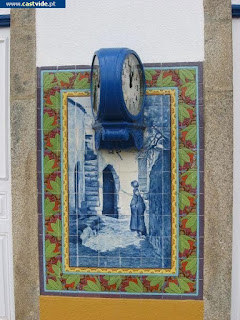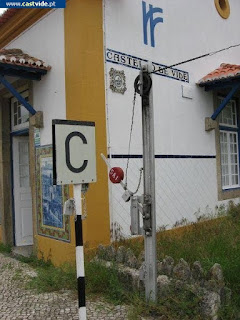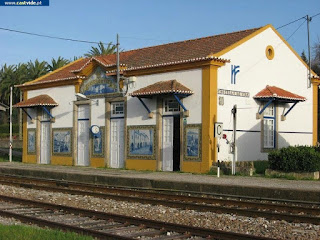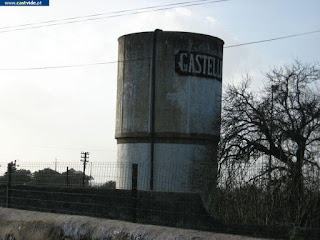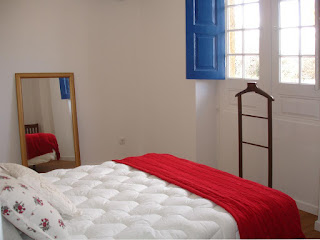- - - - - - - - - - - - - - - - - - - - - - - - - - - - - - - - - - -
This photos below are not original of Castelo de Vide blog, fount:
https://www.travel-in-portugal.com
LocationThis interface is located near the town of Castelo de Vide.Roadways and platformsIn January 2011, it had 2 lanes of circulation, both with 215 meters in length, and a platform, with 95 meters of extension, and 40 centimeters of height.Tile panelsThe station is decorated with several panels of tile with hyperrealistic painting, depicting various aspects of the traditional experience, and some monuments of the village, such as the "Fonte da Vila" painting, contrasting with modernist, polychrome, and vegetal elements. The tiles are made by Jorge Colaço, and were produced by Fábrica Lusitânia.HistoryInauguration and expansionThe construction of the Cáceres Branch began on July 15, 1878, by the Royal Company of the Portuguese Railways; the opening to the service occurred on October 15 of the following year, but the official inauguration was only made on June 6, 1880. The opening of this station made possible an increase in commercial relations, considerably improving the economic situation of the locality of Castelo de Vide.Connection to Fratel and EstremozA decree of June 27, 1907 provided for the construction of a line between Estremoz on the Évora Line and Castelo de Vide which was to be completed within three years. A technical committee, meeting in 1929 to study rail links in Portugal, presented a proposal for a wide line connecting Fratel, on the Beira Baixa Line, to Estremoz, through Castelo de Vide. At the beginning of the 1930s, the macadam of the road from Póvoa e Meadas to Castelo de Vide and the railway station was renovated, an improvement that was very important due to the bad state in which the road was.XXI centuryOn February 1, 2011, the company Comboios de Portugal finished all the regional trains in the Cáceres branch, leaving this station without any services.
Pensão Destino is located in Castelo de Vide. Free WiFi access is available. Set in the renovated old train station, each room here will provide you with air conditioning. Featuring a bath or shower, private bathroom also comes with free toiletries. Extras include bed linen. At Pensão Destino you will find a garden, a terrace and a shared kitchen. Other facilities offered at the property include a shared lounge. The property offers free parking. Featuring the original tiles, this guest house is 13 km from de medieval village of Marvão and 16 km from Portalegre.
Localização
Esta interface encontra-se junto à localidade de Castelo de Vide.
Vias de circulação e plataformas
Em Janeiro de 2011, apresentava 2 vias de circulação, ambas com 215 metros
de comprimento, e uma plataforma, com 95 metros de extensão, e 40 centímetros
de altura.
Painéis de azulejo
A estação está decorada com vários painéis de azulejo com pintura hiper-realista,
retratando vários aspectos da vivência tradicional, e alguns monumentos da
vila, como o quadro "Fonte da Vila", contrastando com molduras
rectilíneas de carácter modernista, policromadas e com desenhos de elementos
vegetalistas. Os azulejos são da autoria de Jorge Colaço, e foram produzidos
pela Fábrica Lusitânia.
História
Inauguração e expansão
A construção do Ramal de Cáceres iniciou-se em 15 de Julho de 1878, pela
Companhia Real dos Caminhos de Ferro Portugueses; a abertura ao serviço deu-se no
dia 15 de Outubro do ano seguinte, mas a inauguração oficial só foi realizada
em 6 de Junho de 1880. A abertura desta estação possibilitou um aumento nas
relações comerciais, melhorando consideravelmente a situação económica da
localidade de Castelo de Vide.
Ligação prevista a a Fratel e Estremoz
Um decreto de 27 de Junho de 1907 previu a construção de uma linha entre
Estremoz, na Linha de Évora, e Castelo de Vide, que devia estar concluída no
prazo de 3 anos. Uma comissão técnica, reunida em 1929 para estudar as ligações ferroviárias
em Portugal, apresentou uma proposta para uma linha de via larga, ligando
Fratel, na Linha da Beira Baixa, a Estremoz, passando por Castelo de Vide. Nos princípios da Década de 1930, foi renovado o macadame da estrada de Póvoa
e Meadas até Castelo de Vide e a estação ferroviária, um melhoramento que foi
muito importante devido ao mau estado em que a estrada se encontrava.
Século XXI
No dia 1 de Fevereiro de 2011, a empresa Comboios de Portugal terminou
todos os comboios Regionais no Ramal de Cáceres, ficando esta estação sem
quaisquer serviços.







